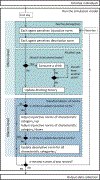The Normative Underpinnings of Population-Level Alcohol Use: An Individual-Level Simulation Model
- PMID: 32090651
- PMCID: PMC7069782
- DOI: 10.1177/1090198119880545
The Normative Underpinnings of Population-Level Alcohol Use: An Individual-Level Simulation Model
Abstract
Background. By defining what is "normal," appropriate, expected, and unacceptable, social norms shape human behavior. However, the individual-level mechanisms through which social norms impact population-level trends in health-relevant behaviors are not well understood. Aims. To test the ability of social norms mechanisms to predict changes in population-level drinking patterns. Method. An individual-level model was developed to simulate dynamic normative mechanisms and behavioral rules underlying drinking behavior over time. The model encompassed descriptive and injunctive drinking norms and their impact on frequency and quantity of alcohol use. A microsynthesis initialized in 1979 was used as a demographically representative synthetic U.S. population. Three experiments were performed in order to test the modelled normative mechanisms. Results. Overall, the experiments showed limited influence of normative interventions on population-level alcohol use. An increase in the desire to drink led to the most meaningful changes in the population's drinking behavior. The findings of the experiments underline the importance of autonomy, that is, the degree to which an individual is susceptible to normative influence. Conclusion. The model was able to predict theoretically plausible changes in drinking patterns at the population level through the impact of social mechanisms. Future applications of the model could be used to plan norms interventions pertaining to alcohol use as well as other health behaviors.
Keywords: alcohol use; individual-level simulation modeling; social norms.
Conflict of interest statement
Conflicts of interest
None.
Figures





References
-
- Ajzen I, & Fishbein M (1980). Understanding attitudes and predicting social behavior: Prentice-Hall.
Publication types
MeSH terms
Grants and funding
LinkOut - more resources
Full Text Sources
Medical

